Brancusi's Studio, Paris
- Laurie Seban

- Jun 30, 2022
- 7 min read
Updated: Jul 17, 2024
The Atelier Brancusi at the Pompidou is a showcase of the ideas and abstract sculptures of early modern sculptor Constantin Brancusi.
If you’d like a respite for your mind and body as you visit Paris museums, try the Atelier Brancusi. It is one of the most tranquil museum sites in all of Paris—and it’s free!

Constantin Brancusi was one of the first 20th century sculptors, transforming bronze, stone and wood into iconic modern masterpieces. His studio, a gift to France, is a perfect distillation of Brancusi’s thought process, a search for sublime simplicity.
Brancusi was born in 1876 to a poor family in a small village in Romania. As a child, he herded his family sheep (imagine him whittling to while away the time in the Carpathian mountains). By the age of 9, he was hired out to work as a domestic, and did so for the next 9 years, carving tools and even a violin as a hobby. Eventually, he entered art school, first in Cralova, then in Bucharest.
In 1903, Brancusi made his way (by foot) to Munich. From there, he traveled to Paris, and enrolled in the Ecole de Beaux-Arts, the school of so many early modern artists, for 2 years. His talent was recognized by Rodin, but he worked for only 2 months in Rodin’s atelier. His reason for leaving? “Nothing grows under big trees,” Brancusi said. And you can see the stylistic differences by comparing their versions of a Kiss.
Auguste Rodin, The Kiss Constanin Brancusi, The Kiss 1907 The Kiss (Bucharest) 1935
Rodin's Kiss was revolutionary in its expressive style. But Brancusi’s Kiss is one the earliest sculpted examples of modern abstraction--reducing his subject to the most elemental forms. Two figures carved from a single block of stone are enclosed in their arms. Isn’t that the essence of love, and a kiss: to become one? The central line and a few deft cuts delineate man from woman, but their mouths and eyes are a unified whole. This early version is still in the Cralova Museum of Art today, but among the many versions in plaster and stone, the WWI Memorial in Bucharest is probably the most famous.
Brancusi was part of the School of Paris, a loose group of early modern artists which included Picasso, Matisse, Modagliani, Duchamp, and the Delaunays. Each had their own style, but all of them worked towards a radical (and revolutionary) reduction of line and color. For Brancusi, simplicity of form was the end product of his search for the truth, the essence of any form.
"In art, one does not aim for simplicity; one achieves it unintentionally as one gets closer to the real meaning of things." Brancusi
Brancusi's singular vision led to the use of his studio as an exhibition space. He submitted a statue titled Princess X to the 1920 Salon des Independents. But organizers deemed it pornographic and had it removed (you can decide for yourself when you see it below). Brancusi was infuriated, and decided to open his studio on the Impasse Ronsin as his own personally curated exhibition space. Through the years, he regularly gave tours. In effect, the artist himself designed his own museum: when he died in 1957 at the age of 81, he left all his work to France, with the stipulation that it be exhibited as it existed in his studio.
The Atelier Brancusi is the result of that, encased in a contemporary building designed by Renzo Piano, tucked into the shadow of the Centre Pompidou. In all, the museum holds over 220 works, along with over 1200 photographs. The hundreds of photographs taken by Brancusi show a constantly shifting tableaux of studio arrangements. They give a whole new meaning to life as art. One photo shows Brancusi on his home-made bench, feet up on a tree trunk. Who wouldn’t want to live like that?

The first room is the original studio, with the opening Brancusi created to connect the 2 adjoining rooms. It still retains echoes of his Romanian heritage, with a hand carved fireplace and massive stone tables which also served as a base for some of his larger works.
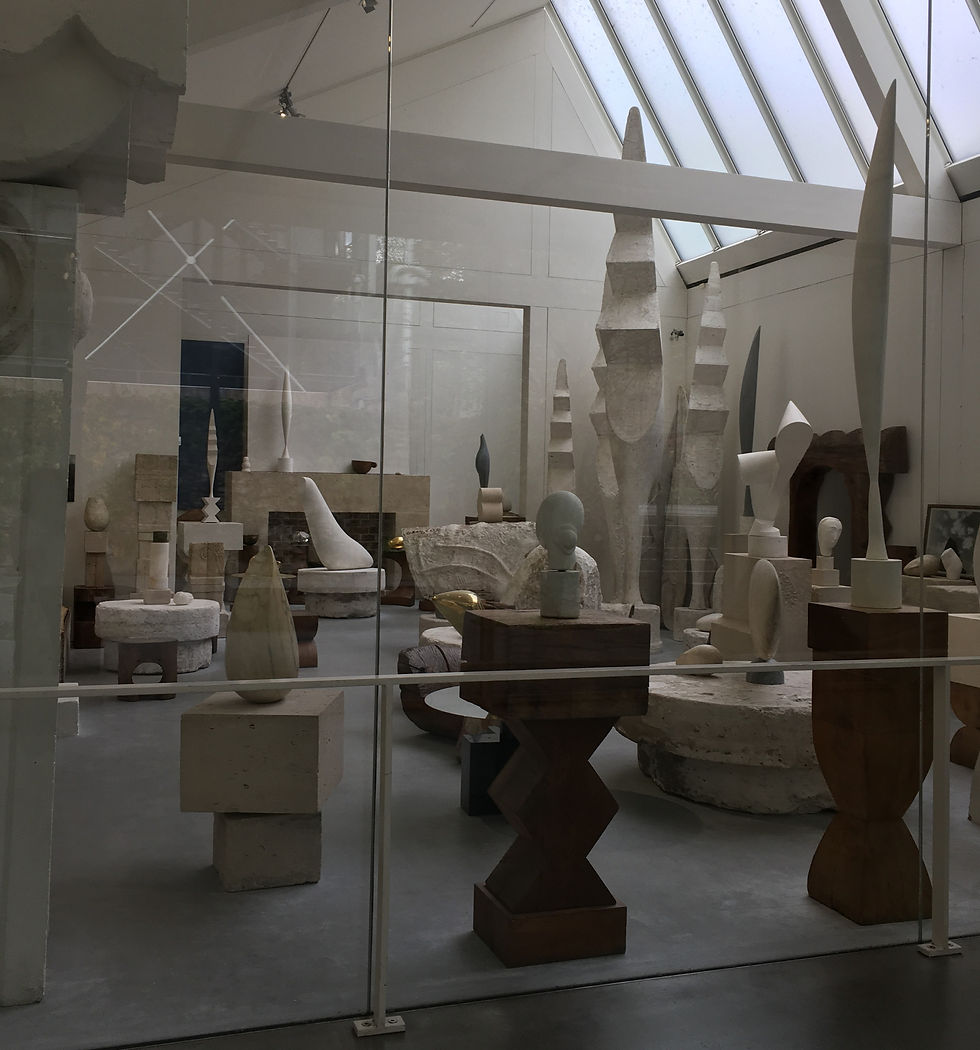
Even behind glass, you can see the studio is still alive with his ideas. Modernism effortlessly merges with the natural world: a forest of verticals and horizontals, angles and curves, textures and forms.

In the eastern corner, a flock of Large Roosters unfolds, like origami in permanent form. Over a 20 year period, Brancusi worked to capture the essence of the birds with their legs and regal stance.
Brancusi didn't think of his works as single entities; he thought of all his works in relationship to each other, varying the proportions, materials and textures in carefully composed groupings. When he sold a work, he replaced it with a plaster model, to retain the cohesive unity of what he called his “mobile groups.”
Large Roosters 1924-44
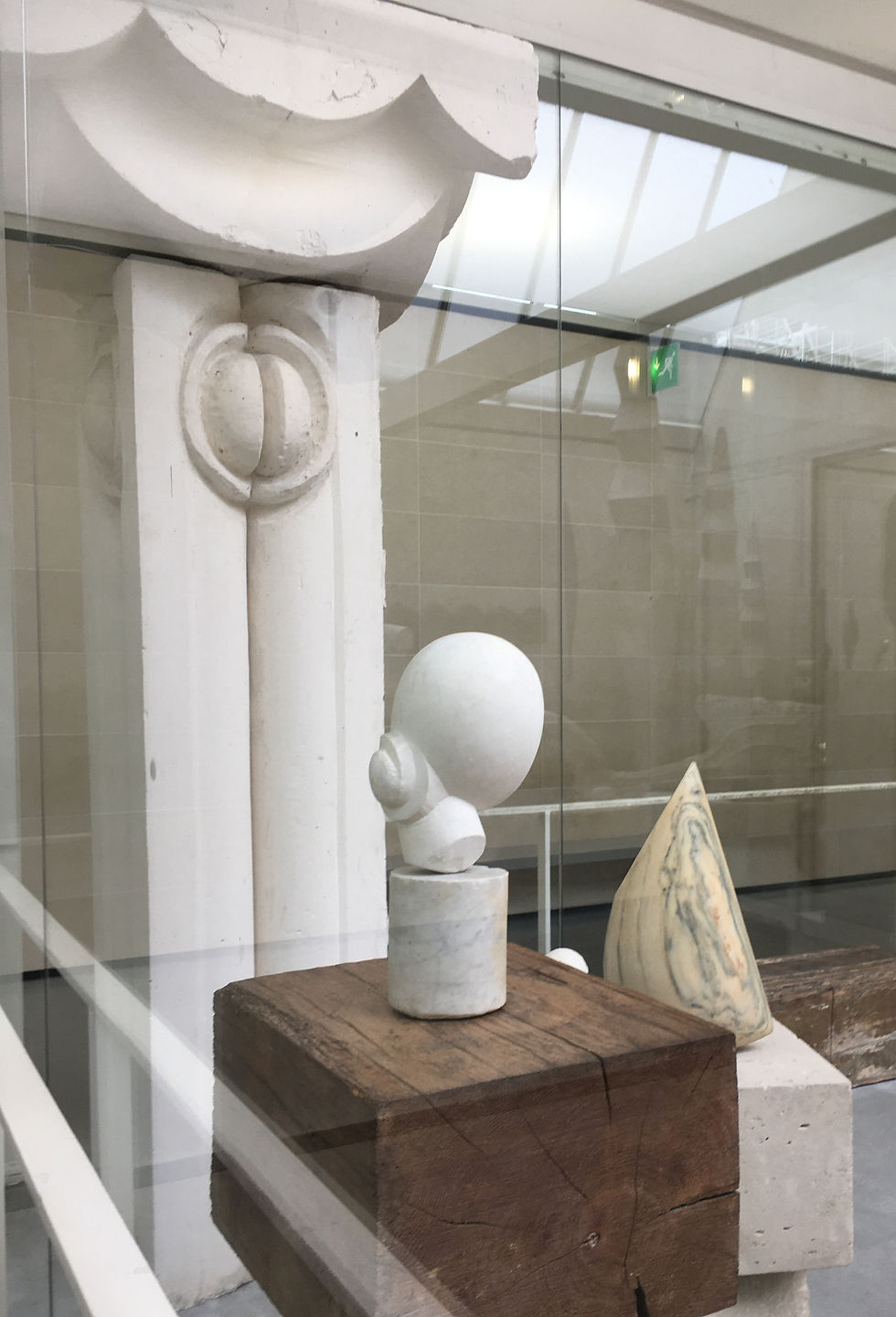
Tucked into one corner, a monumental version of The Kiss stands. In this later version, the features are reduced to one unified circle (mouths or eyes?), while the head of Mademoiselle Pogany looks demurely away. Mme. Pogany, in a variety of poses and versions, is one of the many muses that are a constant presence in the studio—see how many of her heads you can find in the four rooms! Meanwhile, a greatly oversized Little Bird, one of the few works in variegated marble, sits nearby, its breast proudly puffed.
The Kiss c. 1920 Mademoiselle Pogany 1912 Little Bird 1929
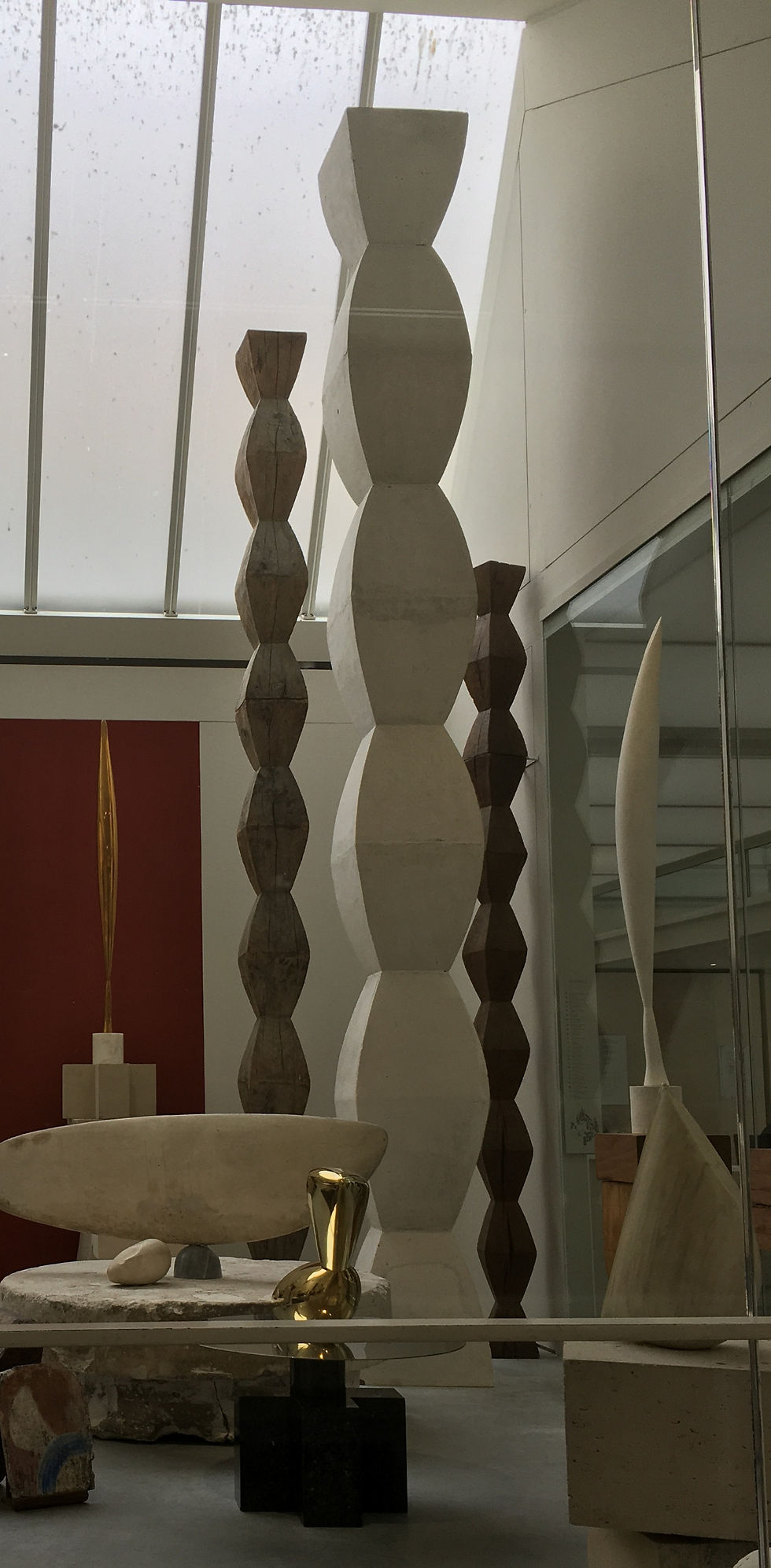
As you turn the corner, 3 Endless Columns, a series of sharp angles that soar upwards, become the core of the room. Each one a different size and material, they take on an organic vitality. You can see Brancusi's facility with media—polished metal, pitted stone, grained wood, smooth plaster.
Endless Columns 1925-26
Especially the way the same form takes on a different character in different media—compare the marble Bird in Space on the right to the gleaming brass version opposite.
You can also see the complementary relationship between sculpture and base in virtually all of Brancusi’s works. Brancusi thought of the work and its base as a harmonious whole, often contrasting natural materials with more polished surfaces. He even created some bases with revolving motors so that the sculpture rotated, and could be admired from all angles.

Back: Bird in Space bronze 1927 & black 1931-36, Sorceress 1916-24, MaleTorso 1917, Endless Columns 1925-26
Mademoiselle Pogany (on bench), Leda 1926 , The Fish 1930
Exquisite equilibrium is the key to understanding Brancusi. Look for the smooth head of (another) Mademoiselle Pogany on a rough hewn bench. Or to the left, a swan-like bronze Leta floating in a reflective metal pool. Just behind, The Fish (1930-1949), a large ellipse, is impossibly suspended on a massive stone table, while a hooded Sorceress oversees the room.

From this view, you can also see two of three versions of Bird in Space, Brancusi’s memory of a mythical Romanian bird who could foretell the future and cure the blind. Each perched on a tower of contrasting bases. In bronze and black marble here, and facing a white marble version opposite, they exist as the perfect synthesis of form and flight.
"I want just the flash of its spirit."--Brancusi
An earlier Bird was also controversial. In 1926, a bronze version was bought and shipped to the US by American photographer Edward Steichen. When it was taxed by a customs officers as metal rather than art (with much higher duty taxes), Steichen sued, and the trial resulted in one of the first 20th century discussions of the legal definition of modern art.
Here, the three birds commune silently in a triangle. They were meant to be part of a Temple commissioned by the Maharaja of Indora, never completed. But they do give a sense of the spiritual resonance Brancusi found in his works, and tried to cultivate for his public.
Bird in Space 1931
In the next room are smaller forms, elegant variations of earlier works. A perfect stone oval looked to be a fish...
White Negress 1923 ; Eileen Lane 1923 , Caryatids with Socrates Cup 1933 & Prometheus (1911)
until I took a step further and discovered it to be a woman, perfectly poised on a series of stone and wood bases. Less graceful is the name: White Negress (the name a reminder of the stereotypes and racism of the last century) Behind are other female forms, including Eileen Lane with her sideswept updo, and two Caryatids regally holding Socrate’s Cup and Prometheus, whose gift of fire is honored as a head in the shape of a flame.
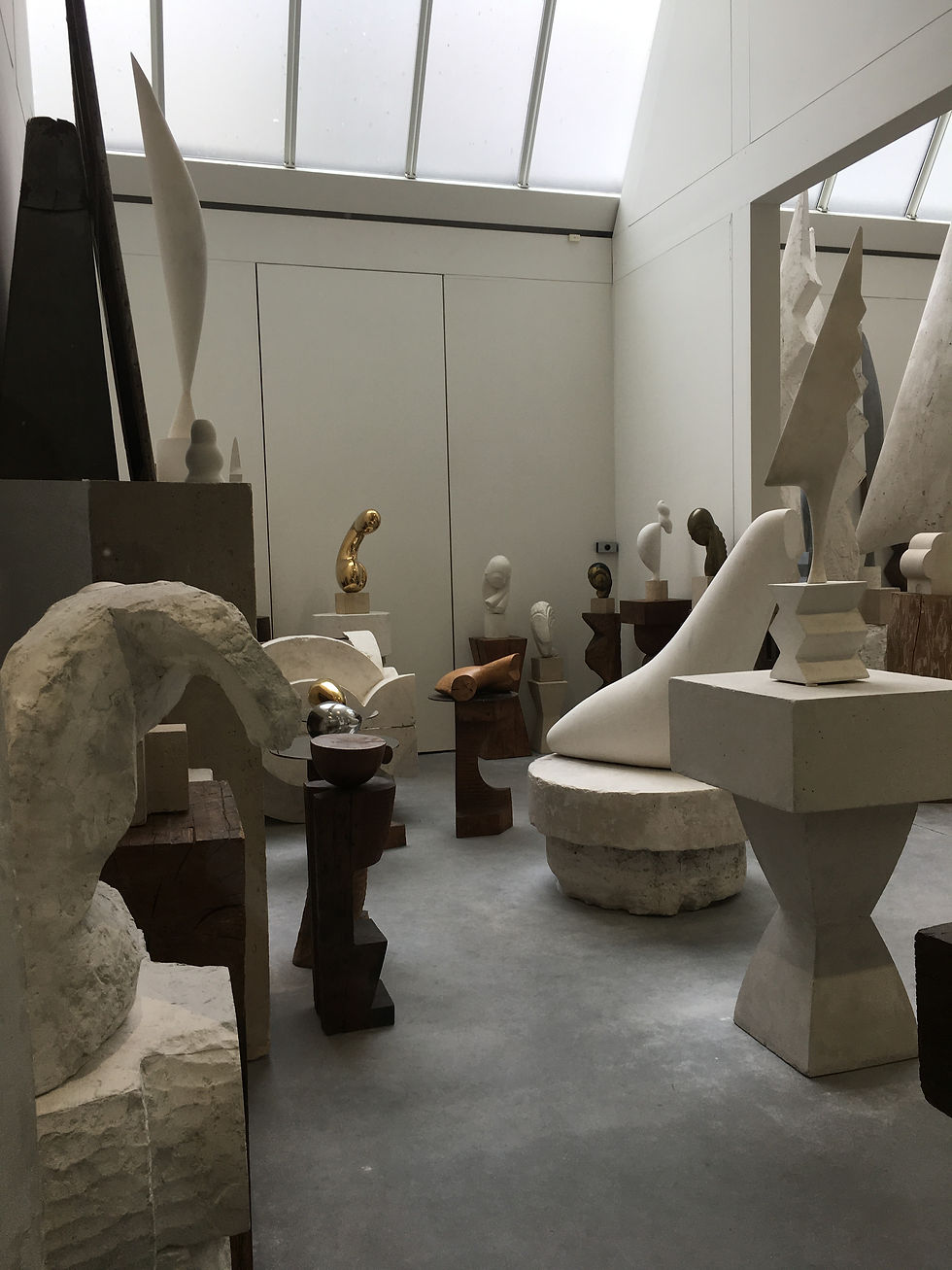
The Miracle 1930 Princess X 1915-16 Muses & Male Torso
A seal called The Miracle is at the center, as in a circus ring, while in the corner, you’ll find other female faces and forms in conversation. In Brancusi’s hands, the oval took on a whole range of expressions.

The infamous Princess X holds court at the back of the room. You can decide for yourself if it looks pornographic. The princess is Marie Bonaparte, a niece of the former emperor who was well-known for her views on pyschoanalysis and sexuality. Brancusi spent 5 years researching what he called “the essence of feminimity.” The statue is usually read as a portrait of the princess looking down at her chest refined in gleaming bronze. Look at the history of female forms, however, and you might see it as a head and torso, with thighs splayed outwards.
Princess X 1915-1916
Rooms 3 and 4 were added in 1930 and 1931 as Brancusi expanded his space and his practice. Above was the actual living space; below, artwork served as a counterpoint to machinery, with all the instruments of a stonecutter and woodcutter’s profession carefully arranged. Tools were used to test his exquisitely balanced creatures. A polished bronze Prometheus lies next to another Bird. Eggs represent The Beginning of the World.
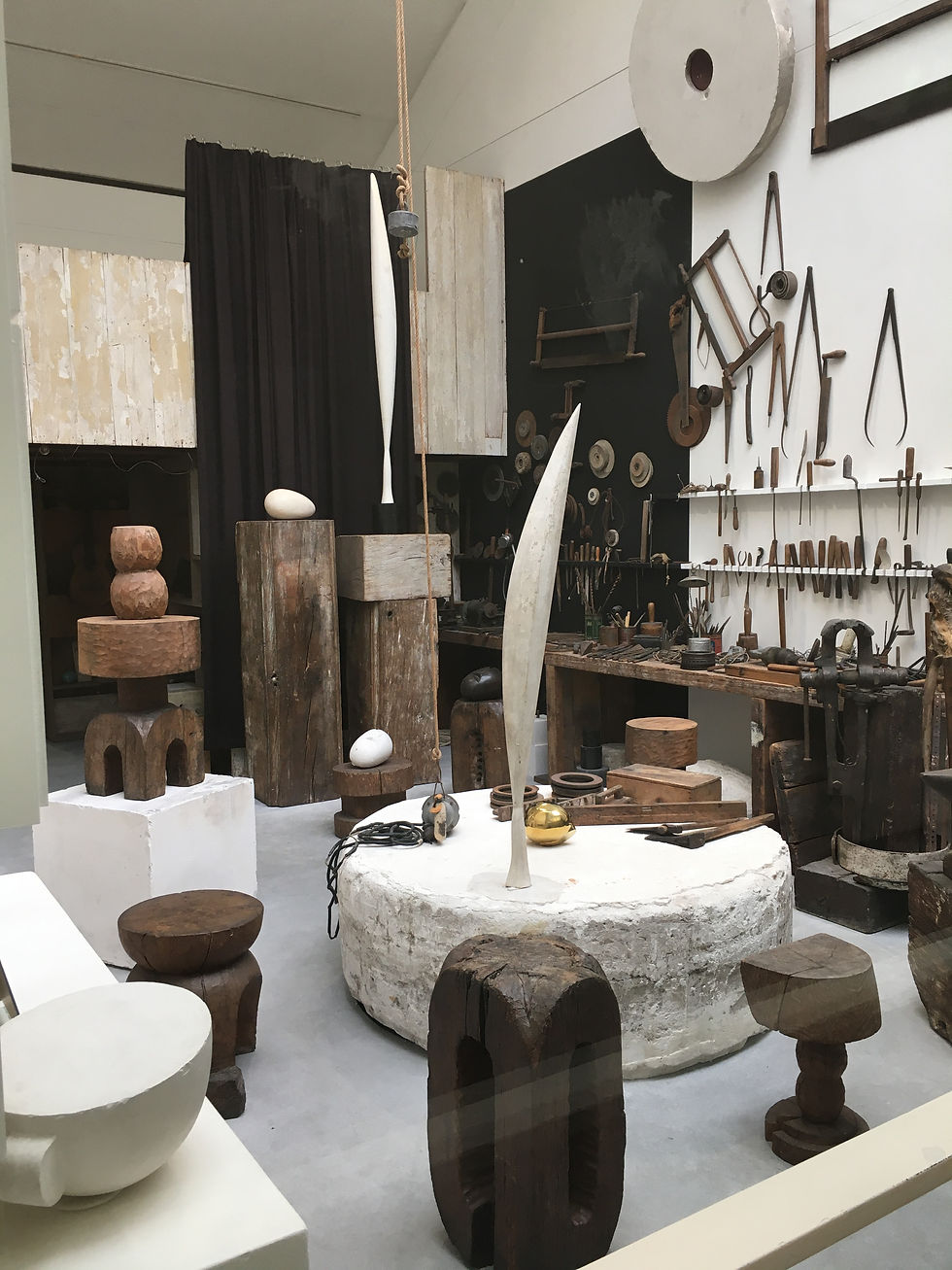
Table with Bird in Space, Prometheus 1911; Beginning(s) of the World 1920-24 i back
Music enlivened the evenings—speakers embedded in stone and plaster could be the first electronic art?
In the last room, a whole series of heads populate the space. Muses with downturned eyes. See the babies? You can recognize first The Sleeping Child, then The Newborn by their wide open shrieking mouth, placed next to small studies of the Kiss.

Front: Birds in Space The Newborn The Kiss 1930 Head of Sleeping Infant 1906-07 with Newborn 1915-20
Sides: Male torsos 1917-22 (left) Sleeping Muses c. 1910 (on right shelf)
To the left, a few male torsos with split legs complement the female heads on the right, who peer over from their shelves to see what is on display.
While you're visiting, you can see Brancusi's own photos, and how he carefully composed his works in hundreds of photos.
It’s not just the muses who are thinking; the studio was a reflective space as Brancusi returned to the same ideas and forms over the course of his long career. Of all the museums in Paris, this is the one that most feels like a temple, a meditative space. If it’s quiet, you can experience the cleansing purity of the natural world honed to its purest essence.
Access to the Atelier Brancusi is from 2 to 6 p.m. every day except Tuesdays and 1st of May.
For more info:



















Comments